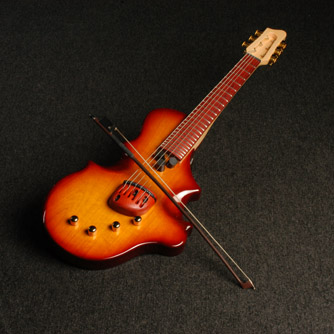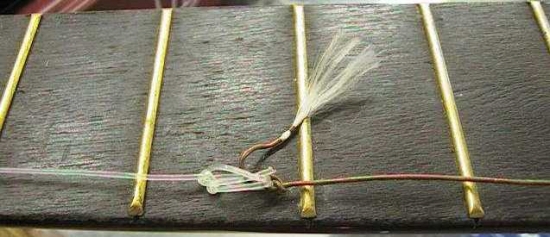Hello and welcome to the first installment of "Mutant Guitars". This column is intended to be a celebration of "functionally unusual" guitars, their utilitarian purpose, and the visionaries behind their design. Mutant guitar designers not only dare to take the "road less traveled", they often blaze new trails. In an effort to arrive at an intended result, they often make surprising new discoveries along the way. Although M.G.'s often have bizarre aesthetics, bizarre aesthetics do not define a "Mutant Guitar". "Alternative musical function beyond common convention" defines a true Mutant Guitar in the context of this column. The design must be somehow derived from the guitar gene-pool.
At the close of each installment of Mutant Guitars, there will be an "off topic" photo of a "Repair shop folly". In Repair shop follies we take a humorous look at the desperate measures that amateur "do it yourself" repair technicians will take to repair their guitars. Though the follies are real, the identities of the guitars (and their owners) are withheld to protect the guilty from public humiliation.
The first Mutant Guitar we will examine is the creation of yours truly. While this may be perceived as shameless self promotion, it behooves me to qualify myself (to you readers) as a true champion of mutant guitar designers. It is to my Mutant Guitar building comrades that I tip my hat and dedicate this column. -- Doctor Bow aka "Jonathan Wilson"
During the 15th century in Spain, viols and viola da gambas were essentially bow-able guitars ("leg viols") that predated modern violins and cellos. They usually had six or seven strings and a fretted fingerboard. Like today's guitarists, viol players used varied tunings and improvised (jammed). For more information visit Jonathan Dunford's excellent web site on Viols.
The "Arpeggione" was a bowed guitar invented by Viennese luthier named Johann Stauffer in 1823. (Stauffer taught a certain apprentice named C.F. Martin how to build guitars.) Franz Schubert wrote a fine sonata for it. Today, Schubert's "Arpeggione Sonata" is commonly played on the Cello. Back in the 1960's, Eddie Phillips of a band called "The Creation" may have predated Jimmy Page's use of a bow on the electric guitar. Although some cool effects were achieved, the guitars traditionally flat string plane will not allow for effective bowing. Phillips and Page were limited to a few psychedellic (and haunting) noises.
Today, the popular Icelandic art rock band "Sigur Ros" is well noted for bowing guitars. It should also be mentioned that Mexico's emerging electric guitar virtuoso Julio Revueltas has developed his guitar bowing techniques to an astonishing degree (suggested Julio Revueltas album listening: "El Alma" and "El Cuerpo").
The TogaMan GuitarViol is essentially is a bow-able guitar; the Jimmy Page guitar bowing concept--on steroids. You may think that Mr. Page's bowing antics were the inspiration behind the TogaMan GuitarViol. Indeed it was the sound of violin, viola and cello music (Vivaldi/Paganini) that prompted my desire to have a guitar that could truly accommodate a bow. The only problem was; the precise embodiment of this instrument did not exist. Simply put, I had to design and build it. (A dangerous thing for a compulsive guitar noodler like me!) What was I after? A bow-able electric guitar of contemporary design.

TogaMan GuitarViol features: Custom "Cana Gold" finished solid alder body, 21.00" scale, satin finished maple neck, paduk fingerboard (Radius 7.5" at nut to 3.25 at 24th fret), proprietary Arco bridge/pickup system (for bowed sounds), EMG magnetic pickups for plucked sounds, active EMG bass/treble EQ., 6 channel gain buffer (for balancing individual string gain levels to the Arco bridge pickup), round violin like string plane (essential for bowing individual strings), hand carved violin/cello shaped body with cutaway access to 24th fret (and beyond), proprietary leg balance cutaway for stability and comfort in sitting the position, flush mount strap locks in balanced positions for standing position, and Spertzel locking tuners. Earvana compensated nut.
For more information, go to BowedGuitar.com.
Repair shop folly of the month:

"One of my favorite follies is the string splice. This one is a hybrid; wound and nylon! Half way up the neck!! Talk about unique tone! Watch out for the knot!"
Doctor Bow (aka Jonathan Wilson) is an experimental guitar noodler who also doubles as a professional guitar technician, designer, luthier, teacher, composer, and assistant manager of Cassells Music in San Fernando, CA. His designs include the "Guillermo Roberto" bajo quinto line and, most notably, the "TogaMan" GuitarViol (bow-able guitar).
Jonathan endorses Earvana compensated nuts and installs them on his TogaMan GuitarViols as a standard feature.